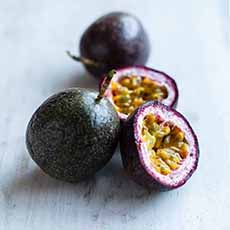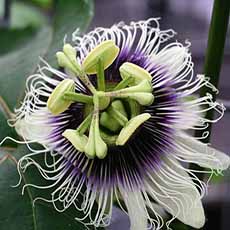Passionfruit Margarita Recipe for National Margarita Day
|
Each year on National Margarita Day, February 22nd, we publish a Margarita recipe. We’ve covered classic recipes and numerous fruits and other flavors: cherry, cranberry, ginger, guava, grape, grapefruit, kiwi, orange, peach, pineapple, pomegranate, strawberry, watermelon, and even a veggie Margarita with spring peas and tarragon. We now have more than 30 Margarita recipes. Today, a new fruit enters the fold: passionfruit, in a Margarita recipe by Chef Tom Fraker of Melissa’s Produce (photo #1). The recipe is below. But first, the history of the Margarita and a bit about passionfruit. (You can spell it passionfruit or passion fruit. Both are correct. Its name is different in other languages*, including liliko’i in Hawaiian.) The purple passionflower climbing vine (Passiflora edulis f. edulis), a plant with spectacular flowers (photos #3 and #4), is native to subtropical South America. The origin of the purple passionfruit stretches from southern Brazil to northern Argentina. The much larger (and less flavorsome) yellow passionfruit (Passiflora edulus f. flavicarpa) may have also originated in Amazonian Brazil, but it is not known for certain. Neither variety was well documented before the arrival of Europeans, but it was part of the local diet. European missionaries used it as an educational aid while trying to convert the indigenous peoples to Christianity. The design of the flower was used to illustrate the five wounds in the crucifixion of Christ. It got its English name around 1700, when it was called the passionflower after the Passion of Jesus. The fruit of the passionflower is, in turn, the passionfruit (photo #2). Passionfruit is actually a large berry. It’s round, about three inches long, with a thick, waxy rind that becomes wrinkly as the fruit ripens (photo #3). The gelatinous pulp inside is composed of sacs filled with orange-colored juice and seeds. The seeds are small, black, and crunchy seeds. The hard outer rind contains the pulp, sacs of orange-colored juice, and black seeds. The pulp can be easily scooped out with a spoon. Or, scoop the pulp into a bowl. If it’s too tart, sprinkle it with a bit of sweetener. Some people add cream. The more wrinkled the skin, the riper the fruit (photo #3). Green passionfruit isn’t ripe. In addition to eating the pulp, it can be: 1. FILL half of a cocktail shaker with ice. Add the rest of the ingredients, except for the salt. Place the cap on the shaker and shake vigorously for 30 seconds. 2. RUB a lime wedge around the rim of 2 Margarita glasses (substitute rocks glasses). Pour the salt onto a plate and dip and twist the glasses into the salt to coat the rim. 3. POUR the drinks into the glasses. |
|
|
|
________________ *Spanish missionaries called the flower of the Passiflora edulis the flor de las cinco lagas (flower of the five wounds) because it illustrated the crucifixion of Christ. †The juice is made from simply squeezing the juice sacs. Passionfruit nectar is made from the entire passion fruit, rind and all; not just the pulp. The fruit is cut up and simmered in water until soft. It’s then strained (if desired) and sweetened. Here’s a recipe.
|
||







